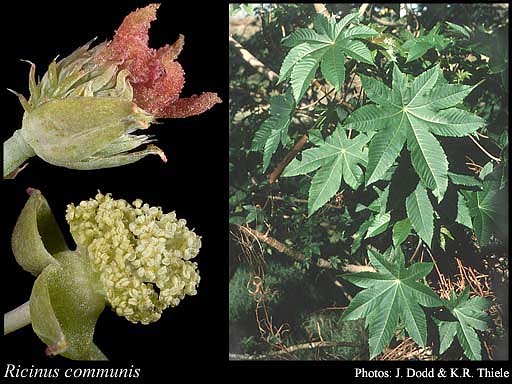- Reference
- Sp.Pl. [Linnaeus] 2:1007 (1753)
- Conservation Code
- Not threatened
- Naturalised Status
- Alien to Western Australia
- Name Status
- Current
Shrub, to 5 m high. Fl. cream-yellow/red, mainly Jun to Sep. Waste grounds.

Distribution
- IBRA Regions
- Coolgardie, Dampierland, Geraldton Sandplains, Indian Tropical Islands, Jarrah Forest, Murchison, Ord Victoria Plain, Pilbara, Swan Coastal Plain.
- IBRA Subregions
- Eastern Goldfield, Eastern Murchison, Geraldton Hills, Northern Jarrah Forest, Perth, Pindanland, Purnululu, Roebourne.
- IMCRA Regions
- Leeuwin-Naturaliste, Shark Bay, WA South Coast.
- Local Government Areas (LGAs)
- Broome, Bunbury, Canning, Capel, Cockburn, Cocos Islands, Cottesloe, Dundas, East Pilbara, Esperance, Fremantle, Gosnells, Greater Geraldton, Halls Creek, Harvey, Melville, Menzies, Nedlands, Northampton, Port Hedland, Rockingham, Shark Bay, South Perth, Stirling, Swan, Toodyay.
Management Notes (for the Swan NRM Region)
General Biology. Growth form. Shrub/Small tree. Reproduction. Seed. Dispersal. Water, ants, explosive action, garden refuse. Time to first flowering. <1 year. Toxicity. Seeds are poisonous to humans and livestock. Vegetative regeneration strategy. Resprouts. Woody structure. Soft. Seedbank persistence. Soil, medium-long, 1-10 years. Fire response. Fire triggers germination of the soil seed bank.
Notes. Disturbance triggers mass seed germination.
Additional information. Origin. Tropical Africa/Asia, America. History of use/introduction. Garden escape.
Suggested method of management and control. Hand pull seedlings and small plants, ensuring roots are removed. Cut and paint using 50% glyphosate or apply 250 ml Access® in 15 L of diesel to base 50 cm of trunk. Foliar spray seedlings and small plants using 1% glyphosate. Read the manufacturers' labels and material safety data sheets before using herbicides. For further information consult the Australian Pesticides and Veterinary Medicines Authority to determine the status of permits for your situation or state.
Management Calendar
| Calendar Type | Jan | Feb | Mar | Apr | May | Jun | Jul | Aug | Sep | Oct | Nov | Dec | Comments |
|---|---|---|---|---|---|---|---|---|---|---|---|---|---|
| Optimum Treatment | O | O | Y | Y | Y | Y | |||||||
| Active Growth | Y | Y | Y | Y | O | O | O | O | Y | Y | Y | Y | |
| Flowering | Y | Y | Y | O | O | O | O | O | O | O | Y | Y | |
| Fruiting | Y | Y | Y | Y | Y | O | O | Y |
Legend: Y = Yes, regularly, O = Occasionally, U = Uncertain, referred by others but not confirmed.
References
- Brown, K. & Brooks, K. (2002) Bushland Weeds: A Practical Guide to their Management. Environmental Weeds Action Network, Greenwood.
- Hussey, B.M.J., Keighery, G.J., Dodd, J., Lloyd, S.G. & Cousens, R.D. (2007) Western Weeds. A guide to the weeds of Western Australia. 2nd Edition. The Plant Protection Society of Western Australia, Victoria Park.
- Muyt, A. (2001) Bush invaders of South-East Australia: A guide to the identification and control of environmental weeds found in South-East Australia. R.G. & F.J. Richardson, Melbourne.
- Navie, S. & Adkins, S. (2008) Environmental Weeds of Australia, An interactive identification and information resource for over 1000 invasive plants. Centre for Biological Information Technology, The University of Queensland.
- Parsons, W.T. & Cuthbertson, E.G. (2001) Noxious weeds of Australia. 2nd Edition. CSIRO Publishing, Collingwood.